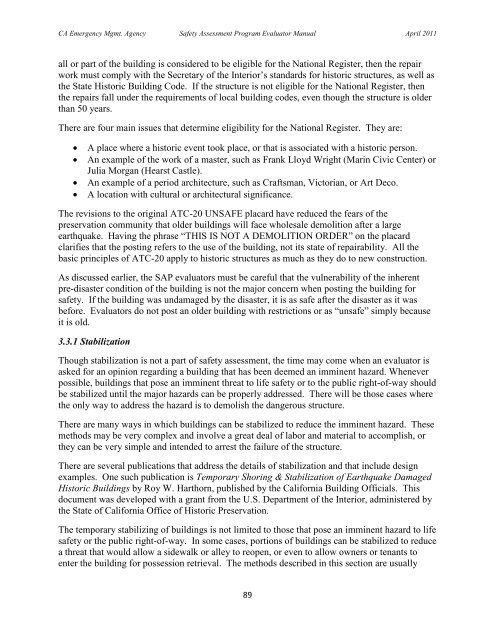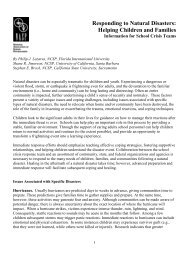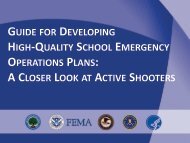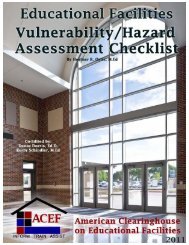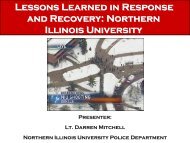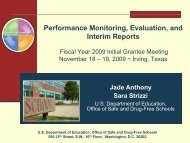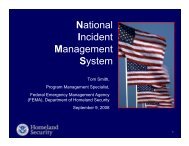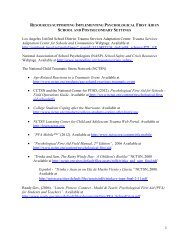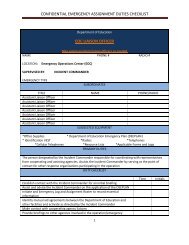Safety Assessment Program Evaluator Student Manual
Safety Assessment Program Evaluator Student Manual
Safety Assessment Program Evaluator Student Manual
You also want an ePaper? Increase the reach of your titles
YUMPU automatically turns print PDFs into web optimized ePapers that Google loves.
CA Emergency Mgmt. Agency <strong>Safety</strong> <strong>Assessment</strong> <strong>Program</strong> <strong>Evaluator</strong> <strong>Manual</strong> April 2011all or part of the building is considered to be eligible for the National Register, then the repairwork must comply with the Secretary of the Interior‟s standards for historic structures, as well asthe State Historic Building Code. If the structure is not eligible for the National Register, thenthe repairs fall under the requirements of local building codes, even though the structure is olderthan 50 years.There are four main issues that determine eligibility for the National Register. They are:A place where a historic event took place, or that is associated with a historic person.An example of the work of a master, such as Frank Lloyd Wright (Marin Civic Center) orJulia Morgan (Hearst Castle).An example of a period architecture, such as Craftsman, Victorian, or Art Deco.A location with cultural or architectural significance.The revisions to the original ATC-20 UNSAFE placard have reduced the fears of thepreservation community that older buildings will face wholesale demolition after a largeearthquake. Having the phrase “THIS IS NOT A DEMOLITION ORDER” on the placardclarifies that the posting refers to the use of the building, not its state of repairability. All thebasic principles of ATC-20 apply to historic structures as much as they do to new construction.As discussed earlier, the SAP evaluators must be careful that the vulnerability of the inherentpre-disaster condition of the building is not the major concern when posting the building forsafety. If the building was undamaged by the disaster, it is as safe after the disaster as it wasbefore. <strong>Evaluator</strong>s do not post an older building with restrictions or as “unsafe” simply becauseit is old.3.3.1 StabilizationThough stabilization is not a part of safety assessment, the time may come when an evaluator isasked for an opinion regarding a building that has been deemed an imminent hazard. Wheneverpossible, buildings that pose an imminent threat to life safety or to the public right-of-way shouldbe stabilized until the major hazards can be properly addressed. There will be those cases wherethe only way to address the hazard is to demolish the dangerous structure.There are many ways in which buildings can be stabilized to reduce the imminent hazard. Thesemethods may be very complex and involve a great deal of labor and material to accomplish, orthey can be very simple and intended to arrest the failure of the structure.There are several publications that address the details of stabilization and that include designexamples. One such publication is Temporary Shoring & Stabilization of Earthquake DamagedHistoric Buildings by Roy W. Harthorn, published by the California Building Officials. Thisdocument was developed with a grant from the U.S. Department of the Interior, administered bythe State of California Office of Historic Preservation.The temporary stabilizing of buildings is not limited to those that pose an imminent hazard to lifesafety or the public right-of-way. In some cases, portions of buildings can be stabilized to reducea threat that would allow a sidewalk or alley to reopen, or even to allow owners or tenants toenter the building for possession retrieval. The methods described in this section are usually89


